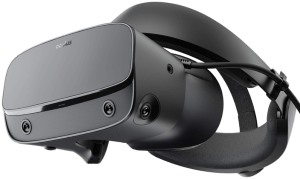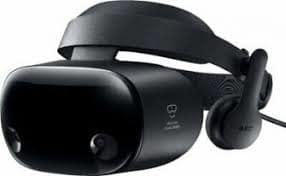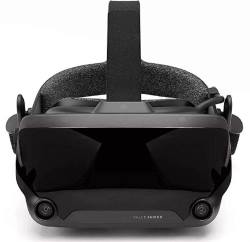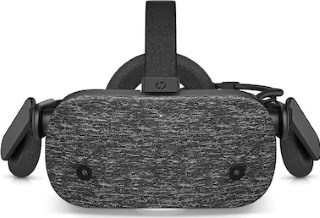Seeing you here reading this article, chances are you are a racing enthusiast. You most probably already own a PC gaming rig and a racing wheel with pedals to go along with. Maybe even a custom racing seat with a gear shifter and some additional gadgets.
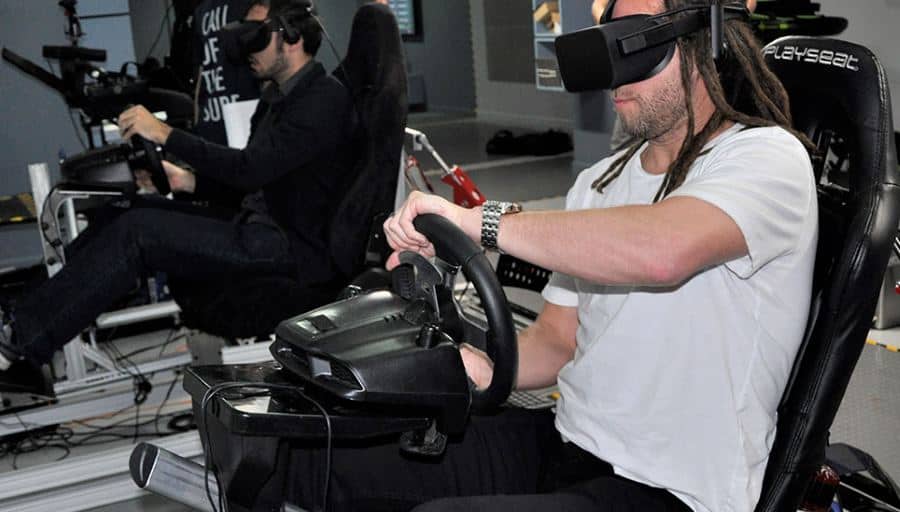
So, you have been pounding away at various racing games, such as iRacing or Assetto Corsa and thoroughly enjoy the experience. However, you want more! Could VR be the next step to improve your current flat screen setup and bring you racing experience to the next level? I believe so!
In this article, you will find 4 different headsets that I think are your best options for sim racing. Near the end of the article, you will also find some general information & tips about using VR in sim racing. So, without further ado, let does dive in!
Entry-Level Top Pick – Oculus Rift S
Headset Type: PC-Tethered | Display Type: LCD (RGB) | Resolution: 1280 x 1440 (per eye) | Refresh Rate: 80Hz | IPD Adjustment: – | Tracking: Inside-out (6 DoF) | Weight: 19.8 oz (561 g) | System Requirements: Intel i5-4590 / AMD Ryzen 5 1500X or greater | GPU: NVIDIA GTX 1060 / AMD Radeon RX 480 or greater | RAM: 8GB+
PROS
+ Adequate resolution & image clarity for sim racing. A significant improvement over Rift CV1 and HTC Vive
+ No external tracking stations means easy & quick setup
+ Comfortable to wear
CONS
– Better field of view would be desirable for sim racing
– Audio quality is lacking
– No Manual IPD adjustment
– SDE is present, especially in cars further away
Oculus Rift S is the follow-up model to the original Rift CV1, which many sim racers used to get their first VR racing experience. So then, is the Rift S a worthy successor that is worth spending your hard-earned money on?
I believe so, yes. The visual quality of the Rift S is finally at a level where it is acceptable for most sim racers to use it as the primary display instead of regular flat screen setup. Do mind me, it is far from perfect though. But it is at a level where the immersion and pros of VR racing overweigh the negatives.
The image clarity and sharpness are good enough for an enjoyable experience and if your PC can handle it, you can fiddle around with supersampling settings to improve it further. With a refresh rate of 80Hz, it will also be easier to push supersampling and still achieve 80fps in the game. And there really won`t be a noticeable difference when compared to a 90Hz headset, for example.
With the Rift S, you will notice some screen door effect here and there. It is not very present in the cockpit (you will find it when you look for it, though), but it is quite prominent with cars at a further distance from you. In that case, you will quite certainly see a grid-like pattern appear in the image.
An area where the Rift S has additional room for improvement is the field of view (FOV). Although when racing, you will mostly be focusing at a distance in front of you, the lack of peripheral vision takes away from the overall immersion you get. And this is actually the problem for most current VR headsets. So, for example, to look further into the sides, instead of gazing with your eyes, you will have to move your head to do so.
On the plus side, the visual sweet spot and area of clarity for the Rift S is good enough that for looking at your lap times / race stats you can glance with your eyes without having to move your head.
If you decide to buy, make sure that your interpupillary distance (IPD) falls between the range of 61.5mm and 65.5mm. The Rift S has no manual IPD adjustment and you will only get optimal experience when your IPD matches the recommended area. If not, then you might seriously consider a headset with manual IPD adjustment, such as the Odyssey Plus which is in the same price range.
Final note. The built-in audio of the Rift S is really quite unsatisfactory. To actually “feel” the engine and get a better overall sound experience, you will have to plug in your own headphones.
Budget-Friendly Alternative – Samsung Odyssey+
Headset Type: PC-Tethered | Display Type: OLED (PenTile) | Resolution: 1440 × 1600 (per eye) | Refresh Rate: 60/90 Hz | IPD Adjustment: + | Tracking: Inside-out (6 DoF) | Weight: 20.8 oz (590 g) System Requirements: Intel i5-4590 / AMD Ryzen 5 1400 or greater | GPU: NVIDIA GTX 1060 / AMD Radeon RX 470 or greater | RAM: 8GB+
PROS
+ Screen door effect (SDE) is minimized
+ Vibrant colors & deep blacks
+ Good quality built-in audio
+ Manual IPD adjustment
+ No external tracking stations means easy & quick setup
CONS
– Quite a small area of visual clarity
– Better FOV is desirable
– Uncomfortable to wear
– SDE filter adds slight blur to objects
A very viable entry-level alternative to the Oculus Rift S is the Samsung Odyssey+. Many sim racers actually prefer the Odyssey Plus over the Oculus headset. Hopefully, the following overview will help to make your own mind about which is the most suitable option for you personally.
Although the Samsung Odyssey+ has a higher nominal resolution than the LCD screen Rift S, due to the OLED (PenTile) display, the overall pixel density is actually smaller. This results in a slightly less sharp image compared to the competitor. While racing, the difference becomes quite noticeable for cars further ahead of you. While with the Rift S you can still see outlines of the cars, for the Odyssey+ it can become just a blur in the same conditions.
The latter is also partly caused by the software-guided anti-screen-door filter that Samsung implemented for the Odyssey+. While it actually does a really good job in terms of limiting SDE (it is barely visible and definitely better than on the Rift S), the edges of objects (especially at a distance), tend to get blurry.
However, where the OLED display lacks in total pixel count, it makes up for more vibrant colors and deep blacks. The colors are just more pleasant to the eye overall, compared to an LCD screen. For example, the cockpit (which is often in darker black colors) seems more true to life with Odyssey+ compared to the slightly washed-out colors you get from Rift S. The same goes for the nature and scenery around you.
When it comes to the field of view of the Odyssey+, it is in the same ballpark as Rift S. The FOV you get is just about sufficient for an immersive experience, but will probably still leave you wanting for more.
However, one of the biggest downsides of the Odyssey+ is the small sweet spot it has. The image is clear at the center of your focus but gradually gets blurry towards to edges. This might mean for some people (depending on headset adjustment, IPD), you have to move your head to look at your race time / position instead of just glancing with your eyes.
Fortunately, Samsung did take the effort to build manual IPD adjustment into the Odyssey+. This means the headset is suitable for a larger crowd of people (IPD range 60mm to 72mm). If you take the time to fiddle around with both the headset as well as IPD adjustment, you are bound to get a good personal fit.
The comfort of the headset, unfortunately, leaves somewhat to te desired for many. For me personally, it was ok based on the little testing I have been able to do. Not quite as comfortable as the Rift S, but not far behind either. However, many people have complained that they just can not find a good fit and after a while, the headset presses too much into your forehead.
Lastly, the built-in earphones of the headset are really quite excellent (made by AKG) with decent and meaty lows going nicely all the way up to the highs. Then again, they have to be, because there is no audio jack to plug in your own headphones.
Overall, the Odyssey+ is a very decent VR headset offering a lot of value for your money and also a serious alternative to consider for the Oculus Rift S.
Oculus Rift S vs Odyssey+ Final Tips & Comparison to Help You Make the Decision
- You can usually find the Samsung Odyssey+ on sale for slighly less than 300$ (check the latest price). This makes it about 100$ cheaper than the Oculus Rift S.
- If your IPD falls out of the range of 61.5mm to 65.5mm, you are probably better of with the Samsung Odyssey+ which has manual IPD adjustment for 60mm to 72mm range.
- Oculus Rift S has a sharper image (especially visible with objects at a distance), while the Odyssey+ has less screen-door effect and more popping colors.
- Rift S is probably the better choice if you have a mediocre PC. With a lower refresh rate / FPS to achieve (80 Hz vs 90 Hz) and a smaller native resolution to fill, it will leave more room for fiddling with settings and achieving the desired output.
- Rift S is the better choice in terms of comfort. If you are going to take part in longer races, it is likely the better option for you.
- Odyssey+ has a noticeably better audio system. With Rift S you will have to use your own headphones for an improved experience.
- If you see yourself also playing other games besides racing sims, Rift S with its more ergonomic controllers and more accurate tracking is the better choice overall.
Top Overall Pick – Valve Index
“For sim racing, you can opt to buy just the headset with one tracking station to save money”
Headset Type: PC-Tethered | Display Type: LCD (RGB) | Resolution: 1440 × 1600 (per eye) | Refresh Rate: 120Hz (144Hz experimental) | IPD Adjustment: + | Tracking: external base stations (6 DoF) | Weight: 28.6 oz (810 g) | System Requirements: Quad-Core processor or better | GPU: Nvidia GeForce GTX 1070 or better | RAM: 8GB+
PROS
+ Improved FOV over all the other headsets on this list.
+ Playing at 120Hz refresh rate gives a superb fluid motion sensation
+ Edge-to-edge clarity of the visuals is excellent
+ Sharp and clear image even for cars and objects at a distance
+ Screen-door effect is very minimal
+ Built-in audio is very good
+ Adjustability of the headset (IPD, lens distance, strap tightness)
+ The Index is comfortable to wear even for prolonger periods
CONS
– Light objects tend to glow over darker surroundings (e.g sun rays coming into the cockpit)
– Software-side hiccups and connectivity issues are to be expected at times. Be ready for some debugging and fiddling.
I am going to start with the fact that if I could choose one headset for sim racing, then it would be the Valve Index. It is just an excellent and well-polished product, with many qualities suitable for racing games specifically.
The resolution and image clarity is finally at a level where you feel that you are not sacrificing visual pleasure to get the benefits that VR offers for sim racing. All the dashes and dials in the cockpit are easily readable and even the objects and cars at a distance are nicely drawn with clear outlines.
An added bonus to the crisp image is that unlike many other headsets where only your focal point is clear, the Index has excellent edge-to-edge clarity. This means you will have no problems glancing at race stats and lap times without having to move your head.
Another improvement over all the other headsets in the list is an increased field of view. You will be better able to see things in your peripheral vision (for example when overtaking a car). Do mind me, the FOV could be even larger for a more immersive and true-to-life experience. However, it is slowly getting where it needs to be.
Moving away from the visuals, the Valve Index does not disappoint elsewhere either. Manual IPD adjustment – check. Lens distance adjustment for maximum FOV – check. Easily adjustable headset straps – check.
Although the headset itself is quite heavy, the adjustability along with the soft face cushioning and evenly distributed weight makes the Valve Index a really comfortable headset to wear. Taking part in an endurance race? No problem, you can literally go for hours without the headset becoming uncomfortable to wear.
Also important for immersive racing experience, the built-in speakers that hover over your ears deliver an excellent sound experience. You will not have to worry about the engine sound being “tinny”. Instead, you get a good quality spatial audio system that does well on the full range of sound frequencies.
Lastly, I am going to mention the fact that if you see yourself using the headset for sim racing only, you can opt to buy just the headset with 1 tracking station. A setup like this is enough for sim racing and would help you save somewhere around 400$.
High-End Alternative Pick – HP Reverb v2
Headset Type: PC-Tethered | Display Type: LCD (RGB Stripe) | Resolution: 2160 × 2160 (per eye) | Refresh Rate: 90 Hz | IPD Adjustment: – | Tracking: Inside-out (6 DoF) | Weight: 17.6 oz (498 g) | System Requirements: Intel® Core™ i7 equivalent or better| GPU: Nvidia GeForce GTX 1080 or better | RAM: 16 GB+
PROS
+ Best resolution & image sharpness you can get
+ SDE is practically eliminated
CONS
– Higher FOV is desirable
– Visual clarity area too narrow
– No manual IPD adjustment
– The fat cable at times, is annoying even for seated sim racing
– a really meaty PC required to take advantage of the headset’s capabilities
The HP Reverb VR headset with its 2160 x 2160 resolution (per eye) is often praised as the go-to headset for both sim racers as well as flight enthusiasts. And for a good reason. But is it a match for the excellent overall package that Valve has put out with the Index headset?
The most significant and unique advantage of the HP Reverb is indeed the resolution and sharp image it is able to output. There currently is no match for it in the consumer-oriented VR headset market.
To give you a very blunt comparison of how good it actually is, I will go ahead and say the following. “It will make the visual quality of the Rift S look like VHS compared to Bluray of the Reverb.” And please do mention here, that the visual quality of the Rift S is actually very adequate. It’s just that the Reverb is simply that good.
A high-resolution pixel-dense image also means that there is virtually no screen-door effect anymore. Also, the colors that the Reverb is able to output are actually really nice for an LCD RGB display.
On the negative side, the visual sweet area of the Reverb is quite narrow. So, your immediate focus point is clear and crisp, but the surrounding areas gradually get blurrier and blurrier. This is a problem if you want to see the race stats for example, for which you might have to move your head.
Also, the field of view of the Reverb is comparable to the Rift S and Odyssey+, but falls behind when putting it against the Valve Index. And like I said, for sim racing, I wish the FOV was even wider than the Index is able to output.
The Reverb also doesn’t have manual IPD adjustment and is calibrated for an IPD of 63mm but usable for people in the 55mm – 71mm range. Keep in mind, though that the further your IPD deviates from the 63mm, the more likely you are to benefit from a headset with manual IPD adjustment, such as the Valve Index.
When directly comparing the Reverb with Valve Index, it has an edge in focal point image clarity (not in the edges of the display) and also less screen door effect. In all other areas, I will go ahead and say that the Valve Index is a more optimal choice.
This does not make the Reverb a bad headset, it is just the Valve Index has set the bar really high. I, therefore, recommend the HP Reverb over the Index only if you are a “true visual nerd” who just needs the graphics to the spot on. And only if you have a top-end PC that is actually able to generate the high-quality content.
Valve Index vs HP Reverb Comparison & Final Tips
- HP Reverb has the most pixel-dense and sharp image of pretty much any consumer-oriented VR headset on the market.
- Valve Index has a higher FOV and better edge-to-edge clarity. You will be able to see more objects in your peripheral vision and away from your immediate focal point. This to my mind adds more to the overall experience and immersion than the resolution of the Reverb alone.
- Valve Index has an adjustable refresh rate (80, 90, 120, 144Hz) vs the fixed refresh rate of 90Hz for Reverb. 120Hz certainly feels better and smoother than 90Hz when your PC is able to run it properly. A smaller native resolution also means more room to play with supersampling and graphics options to achieve the desired output.
- Valve Index is much more adjustable (IPD, the eye-relief FOV knob, and head strap tightness knob) compared to the Reverb. It is easier to make it fit for your needs.
- Valve Index is more comfortable to wear and also has a better built-in audio solution.
- Valve Index full package (headset, controllers, 2 base stations) costs about 1000$ at the time of writing. HP Reverb is about 650$. If you want VR only for sim racing, then you can opt to buy only Valve Index headset + 1 base station (~650$)
VR vs Triple Monitor Setup
For a long period, a triple monitor rig was the setup to go for if you wanted a more true-to-life racing experience. The added peripheral vision it grants just makes the overall experience more realistic and enjoyable compared to one monitor or TV setup.
Then when the original Oculus Rift and HTC Vive become to the market in 2016, people started dipping their feet into the VR sim racing world. Years have passed, tech has evolved – so what is the current state and is VR worth it in sim racing?
Pros of using VR in Sim Racing
Sim racing in VR has many advantages over regular flat screens. Firstly, it is about the immersion and experience you get. With VR it might almost feel as you are not playing a game anymore but instead are actually in the car racing. Sure, it is not quite the bumps and creaks of real-life driving, but you get my point.
Secondly, virtual reality can actually improve your driving. The added sense of depth perception (which you can not get from regular flat screens) helps you better estimate the distances and breaking points.
And when you are nearing a corner, you can actually look in the opposite direction of the car travel. This means that before turning the car into the corner, you can measure and estimate the corner apex to hit it perfectly. Those who have tried VR, can appreciate how it adds to the overall racing experience.
What about the Cons?
The biggest downside that is often associated with VR sim racing is a limited field of view that most current VR headsets have. This means that to look at objects placed more in your peripheral vision, you might have to actually move your head instead of just gazing with your eyes.
However, it also true that strapping on a VR headset might easily be compared to wearing a racing helmet in real life. Both add some weight, limit your peripheral vision and might also make you sweat if the racing gets intense. In this sense, the “cons” of VR sim racing are actually the very things that make the experience even more realistic.
Like with most things in life, in the end, the debate between VR vs triple monitor is subjective and opinions differ from person to person. However, the general consensus seems to be that once you have gotten into VR sim racing, there is no going back. To know for sure, I guess you will just have to try it out yourself.
Take Your Time With Settings
If you are in a situation where you have actually already bought a VR headset and also chosen a game to take on, then before you dive in there is a couple of things to do.
First, I advise you to do some googling for the VR headset and game combination you have chosen. The thing about using VR in racing games is that usually, the default settings are really not that good for playing. Often, the head moves too rapidly or there is too much wobble happening. This, however, is quite likely to end with a puking festival.
So, read about the experiences that others have had and the settings they have used for an optimal VR racing experience. Trust me, it is worth taking your time to test these changes out.
Secondly, like with all gaming – you are going to have to find the right balance between graphics and the fps your PC is able to output. If your VR headset has a refresh rate of 90Hz, for example, I suggest you first tune down your graphics settings and see how well it is able to maintain 90 fps in the game. You then start raising various settings step-by-step up to the point your PC is getting on the edge.
I suggest you to not fully utilize the system resources and leave some in reserve. The thing with VR is that the fps is cut in half when your PC is starting to have trouble sustaining the desired fps. So 90fps comes 45fps and every second frame is reprojected using “guessing” methods. This makes for a juddery experience which you do not really want.
At some point, you are most probably going to experience it anyway and then you’ll know what it is and what to do about it.
Getting through the Nausea-phase
If this will be your first time doing racing in VR, you are most probably going to have a hard time in the beginning. The thing is that even if you have fiddled with settings to get the optimal experience, VR is most probably going to induce some nausea during your first races.
It might take you a couple of corners, maybe a lap or two. If you start feeling “weird” or maybe feel some cold sweat forming on your skin, then stop right away. Do not make the mistake I did during my first VR race where I knew that something was wrong but decided to push through it.
For me, this resulted in a pretty much ruined evening with a really horrible nauseous feeling that lasted for hours. So please do yourself a favor and stop racing at once when you are feeling bad.
Take a break, gather yourself and once you feel normal, then you can have a go again. The thing is that your body will adapt to VR racing quite quickly and after a day or two you most probably can go for hours without feeling anything being wrong. It`s just about letting your body adapt to the new sensation and getting over the initial hump.
To Wrap it Up
If you are a person who thoroughly enjoys sim racing, I believe that VR is a well-worth investment to improve your racing experience and also make you a better driver.
If I could choose one headset for VR sim racing and money was not an issue, I personally would go with the Valve Index. However, if you would like to spare some money, then the Oculus Rift S and Samsung Odyssey+ are both excellent choices that will also do their job nicely. Enjoy!
Related Articles
- 3 BEST VR HEADSETS FOR FLIGHT SIMS (TIPS & SPECS TO CONSIDER)
- VR DISPLAY COMPARISON – LCD VS OLED, (SUB)PIXELS, FOV & PPD
- BEST STEAM COMPATIBLE VR HEADSET (2021)
- HTC VIVE COSMOS ELITE VS VALVE INDEX – WHICH IS BEST?
- VR GUIDE FOR PEOPLE WITH GLASSES

